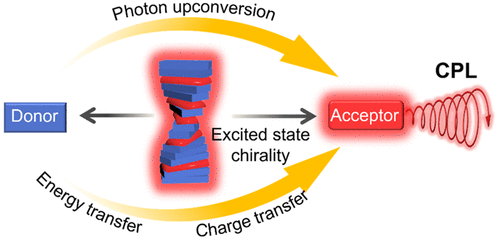当前位置:
X-MOL 学术
›
Acc. Chem. Res.
›
论文详情
Our official English website, www.x-mol.net, welcomes your
feedback! (Note: you will need to create a separate account there.)
New Perspectives to Trigger and Modulate Circularly Polarized Luminescence of Complex and Aggregated Systems: Energy Transfer, Photon Upconversion, Charge Transfer, and Organic Radical.
Accounts of Chemical Research ( IF 16.4 ) Pub Date : 2020-07-10 , DOI: 10.1021/acs.accounts.0c00112 Tonghan Zhao 1, 2 , Jianlei Han 1 , Pengfei Duan 1, 2 , Minghua Liu 1, 2, 3
Accounts of Chemical Research ( IF 16.4 ) Pub Date : 2020-07-10 , DOI: 10.1021/acs.accounts.0c00112 Tonghan Zhao 1, 2 , Jianlei Han 1 , Pengfei Duan 1, 2 , Minghua Liu 1, 2, 3
Affiliation

|
Chiral functional materials with circularly polarized luminescence (CPL) have risen rapidly in recent years because of their fascinating characteristics and potential applications in various research fields. CPL refers to the differential spontaneous emission of left (L)- and right (R)-handed circularly polarized light upon photon or electron excitation. Generally, an outstanding CPL-active material needs to possess a high luminescence dissymmetry factor (glum) (defined as 2(IL – IR)/(IL + IR) where I is the emission intensity), which is between −2 and +2. Although the exciting development in CPL-active materials was achieved, the modulation of CPL signs is still a challenge. For small organic systems, a relatively small glum value, one of the key parameters of CPL, limits their practical applications. Searching for efficient approaches for amplifying glum is important. Therefore, over the past decades, besides optimizing the structure of small molecules, many other strategies to obtain efficient CPL-active materials have been developed. For instance, self-assembly has been well demonstrated as an effective approach to amplify the supramolecular chirality as well as the glum values. On the other hand, chiral liquid crystals (CLCs), which are capable of selective reflection of left- and right-handed circularly polarized light, also to serve as a host matrix for endowing guest emitters with CPL activity and high glum values. However, self-assembly focuses on modulating the conformation and spatial arrangement of chiral emitters. And the CPL of a luminophore-doped CLC matrix depends on the helix pitch and band gap positions. Lately, novel photophysical approaches to modulate CPL signs have gradually emerged.
中文翻译:

触发和调制复杂和聚集系统的圆偏振发光的新观点:能量转移,光子上转换,电荷转移和有机自由基。
近年来,具有圆偏振发光(CPL)的手性功能材料由于其引人入胜的特性和在各个研究领域中的潜在应用而迅速崛起。CPL是指在光子或电子激发后,左旋(L)和右旋(R)圆偏振光的自发差分发射。通常,出色的CPL活性材料需要具有较高的发光不对称因子(g lum)(定义为2(I L – I R)/(I L + I R),其中I是发射强度),介于-2和+2之间。尽管实现了CPL活性材料的激动人心的发展,但是CPL标志的调制仍然是一个挑战。对于小的有机体系,相对小克LUM值,CPL的关键参数之一,限制了它们的实际应用。在搜索用于放大有效途径克LUM是重要的。因此,在过去的几十年中,除了优化小分子的结构外,还开发了许多其他获得高效CPL活性材料的策略。例如,自组装已被充分证明为以放大所述超分子手性的有效方法,以及克LUM价值观。另一方面,能够选择性反射左旋和右旋圆偏振光的手性液晶(CLC),也可以用作赋予CPL活性和高g lum值的客体发射体的基质。然而,自组装集中于调节手性发射体的构象和空间排列。掺杂有荧光团的CLC矩阵的CPL取决于螺旋螺距和带隙位置。近来,调节CPL信号的新颖光物理方法逐渐出现。
更新日期:2020-07-21
中文翻译:

触发和调制复杂和聚集系统的圆偏振发光的新观点:能量转移,光子上转换,电荷转移和有机自由基。
近年来,具有圆偏振发光(CPL)的手性功能材料由于其引人入胜的特性和在各个研究领域中的潜在应用而迅速崛起。CPL是指在光子或电子激发后,左旋(L)和右旋(R)圆偏振光的自发差分发射。通常,出色的CPL活性材料需要具有较高的发光不对称因子(g lum)(定义为2(I L – I R)/(I L + I R),其中I是发射强度),介于-2和+2之间。尽管实现了CPL活性材料的激动人心的发展,但是CPL标志的调制仍然是一个挑战。对于小的有机体系,相对小克LUM值,CPL的关键参数之一,限制了它们的实际应用。在搜索用于放大有效途径克LUM是重要的。因此,在过去的几十年中,除了优化小分子的结构外,还开发了许多其他获得高效CPL活性材料的策略。例如,自组装已被充分证明为以放大所述超分子手性的有效方法,以及克LUM价值观。另一方面,能够选择性反射左旋和右旋圆偏振光的手性液晶(CLC),也可以用作赋予CPL活性和高g lum值的客体发射体的基质。然而,自组装集中于调节手性发射体的构象和空间排列。掺杂有荧光团的CLC矩阵的CPL取决于螺旋螺距和带隙位置。近来,调节CPL信号的新颖光物理方法逐渐出现。











































 京公网安备 11010802027423号
京公网安备 11010802027423号